More Bamaga.
There had been hope that our riding gear would make the afternoon flight from Cairns to Horn Island, and thus arrive by ferry first thing in the morning. Naturally, that didn’t happen, and Roy spent most of the morning “negotiating” with Qantas. Finally, it was decided that Qantas would lower themselves to ship our luggage, but that we had to deal with getting the gear from Horn Island. No worries, mate — Roy has a friend with a helicopter.
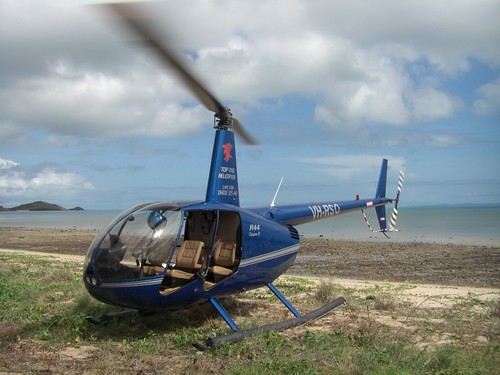
The only potential catch was that we had to make it worth Bungee’s while to come out to Bamaga with his copter. So Roy, ever the businessman, convinced six of us to do a helicopter tour of the area — for a small charge, of course — after which, Bungee was happy to jump over to Horn Island quickly and retrieve our riding gear.
Not surprisingly, the helicopter trip was amazing. Bungee was no normal helicopter tour operator — his copter had no doors, and he was prone to swinging around 360 degrees on a dime to point out a shark in the water or a croc on the beach. He took us south to the Jardine River, over the Injinoo aboriginal lands, and along the coastal beaches. We ventured into the Jardine Swamps, where he flushed out a feral pig and chased it for our amusement, swooping down and cutting it off, then rising again and circling the poor creature as it crashed through the reeds and mud towards the safety of the mangroves.
Seisia from the air:
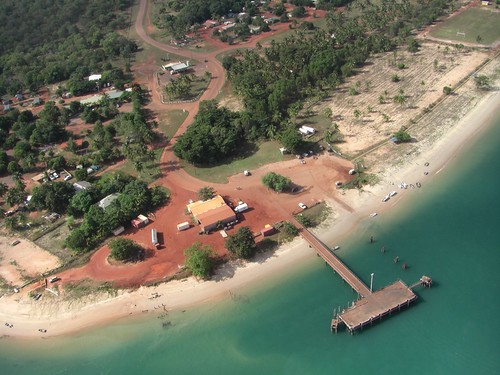
Chasing feral pigs:
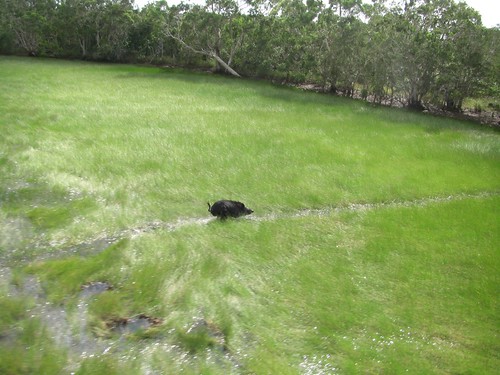
Video of chasing feral pigs:
On the road, finally!
Our gear was procured immediately after our helicopter trip and we quickly geared up for the ride. We found out later that the afternoon’s ride was literally a test — to gauge peoples’ abilities and skill levels amongst the hardest that the Cape has to offer.
The ride started out easily enough, out of the campsite. I had to stop and ask Joel for the best route over the small water crossing — in hindsight, the easiest crossing of the week! We stopped for gas in Bamaga and filled both the main tank and the extra plastic “bum tank” that was fitted to the rear of every motorcycle.
We took off north through the 23,000 ha rainforest known as the Lockerbie Scrub. We stopped briefly at the Croc Tent store, located just opposite of the old Lockerbie homestead, for a quick break.
A still shot from a video of me doing a water crossing:
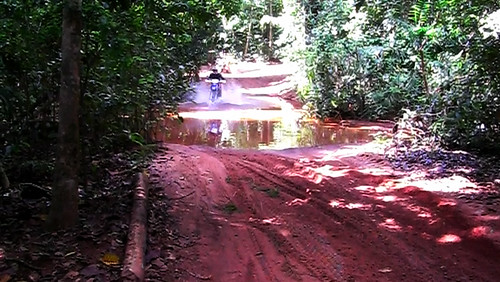
Wanna see the video?
Continuing north, the road turned sandy. Now, I don’t mean “there was some sand on the road.” I don’t mean, “oh, look, here’s an inch or two of sand”. I mean 4×4 tire tracks cutting through a foot, foot and a half, of loose white sand.
I managed to stay upright, but I was definitely cheating by keeping the TTR230 just barely above idle speed and waddling with my tiptoes on the crests of the ruts. Peter was trying to “do it right” — sitting practically on the gas cap to weight the front wheel and using momentum to go through the sand — but he was falling a bit in the process. Sadly, I have no photos of this section of the trip, as I was fairly preoccupied with trying not to die.
By the time we parked at Pajinka to walk to the tip, we were already overheated and dehydrated. Our smaller-sized Camelbaks, which work nicely when stopping to refil them at gas stations every hour on roadbike trips, were not so useful for long trips in the bush.
Not one of the deep sections:
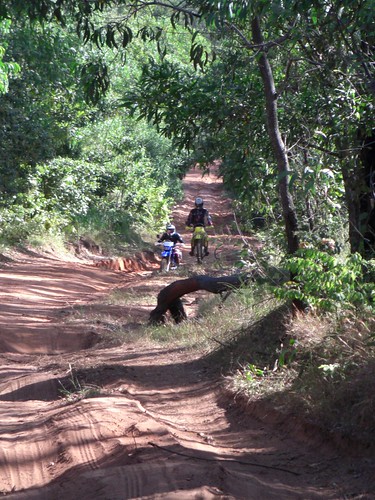
Arriving at Pajinka, the Injinoo name for the very tip of the Cape York Peninsula:
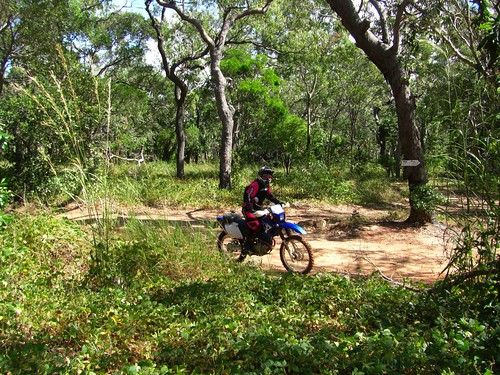
The walk to the tip was slightly easier than it might normally have been, due to it being low tide — we were able to cross over the beach whereas most people climb the rocky ridgeline. There was still some rock climbing to be done towards the end, which is always a treat with metal-toed motocross boots on! It was in the high 20s, Celsius, and the sun beat down relentlessly as it tends to do that close to the equator.
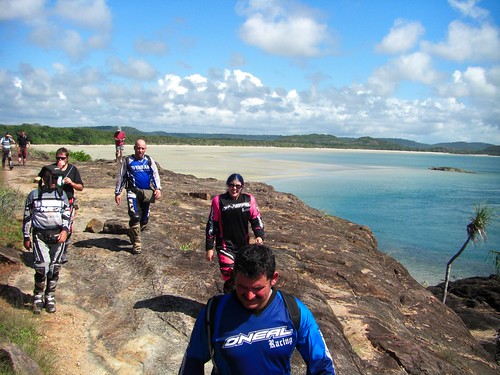
We posed for the requisite photo at the northernmost point of the Australian continent, an achievement that, for me, was slightly overshadowed by the heat and the sun. The walk back to the bikes was rough and I held my Camelbak over my head for shade.
On the rest of the trip, I’d remember to bring my floppy hat in my waist pack…Peter and I called it “Queensland Rule #1” — always bring a hat.
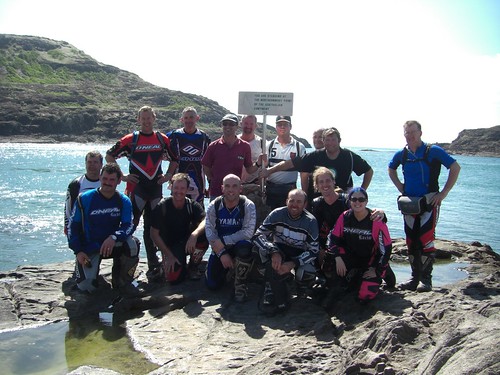
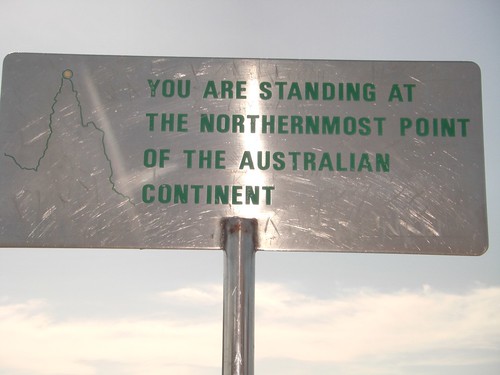
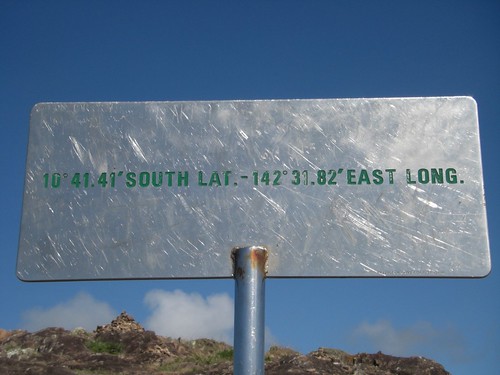
Trouble begins.
After the tip was more sand, scrub, and more sand. There were sections where Joel and Linc advised us to ride in the scrub lining the road, instead of on the road itself, because the road was too sandy and boggy. We were on our way to a beach and, about 100 meters before the parking area, I finally dropped the bike for the first time. Once the “dropping” seal was broken, gravity had its way with me, and I dropped the poor TTR once more before arriving exhausted, frustrated, and sweaty, at the beach area.
Peter, too, was at the end of his rope, having dropped the bike a few times himself. I left
him sitting in the shade besides his bike for a few minutes while I rode down a pile of rocks to the beach itself — after the large sand ruts we’d been riding in, a smooth flat beach was nothing! It was a blast to zip along the coastline, dodging in and out of the surf.
The rest of the group had come across a feral pig on the beach and had chased it into the water, but there was no sign of it now — either it had swum to shore somewhere out of sight or had been snatched up by a hungry croc. The native Australians had no love for feral pigs — as a children’s crayon sign back in Bamaga pointed out:
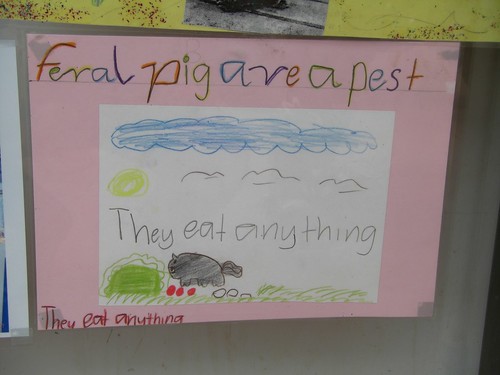
Unfortunately, there was no shade anywhere on the beach, and when I returned to the bike parking area, my already-overheated brain was, well, more overheated. I dropped the bike again on the large pile of rocks between the beach and the parking area…luckily, the rest of the guys had beaten me back and I had plenty of help righting the fallen steed. I did get my first nice bruise of the trip, though!
Linc and Joel had figured out — rightfully — by this point that Peter and I were not only in over our heads but were also stupidly close to heat exhaustion. Rather than risk us in the boggy sand on the way back to the rainforest, they rode our bikes up to the top of the crest then came back to take us each as pillions on their own bikes.
In case riding at 10kph over deep sand wasn’t scary enough, these guys were experts and going at least 40kph, the front wheel skipping and dancing over the sand. Shit, I thought, I’m going to break my arm in this sand, and I won’t even be the one driving! But of course the guys got us through in one piece and soon we were back in the cool comfort of the rainforest Lockerbie scrub.
Our way back to camp was brightened by Linc spotting a black-headed python. I named the little guy Fluffy, which cracked up the Aussies — I think they wanted some squealing and fright from the “young American girl”! Fluffy had little bumps all along his skin, which Linc told us was from parasitic mites that burrow in between the snakes’ scales. Poor Fluffy!
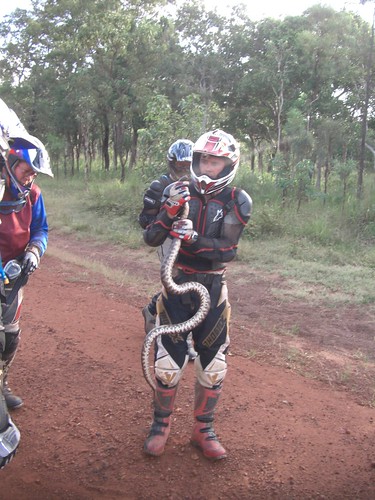

We stopped once more on the way to camp, at a pub in Bamaga. I wasn’t feeling well enough for a can of beer, but I downed cup after cup after cup of water — at least half a gallon — to try to rehydrate.
The joys of universal health care.
Upon returning to camp, we were all sweaty and warm, but I didn’t seem to be cooling off much. I took a cold shower at the camp, which helped somewhat, but by dinnertime, I was disoriented and irritable (more than usual, even!). Peter started believing me that something was actually wrong when I couldn’t even touch the spicy chicken curry that Linc had made for dinner — one of my favorite meals. One of the guys made me an electrolyte drink from some tap water and sports drink powder, but I was having dry heaves by that point and could only sip it.
I had been keeping Roy informed throughout the evening, and finally he asked me, “do you want me to take you to the hospital?” By that point I was warm to the touch, couldn’t stop shivering, and still wasn’t able to eat, so I said yes.
Long story short, Peter, Roy and I huddled into a borrowed truck (taking our own supply truck would have stolen the beer from the rest of the group –even in my muddled state, I wouldn’t have done that to anyone!) and drove into Bamaga.
The day nurse, David, was just finishing up his shift and he set me up in a nice bed under glorious air conditioning. David took my blood pressure, temperature, and a few other vitals and declared that I was slightly dehydrated but not badly enough to require an IV. What I did have, however, was an electrolyte imbalance.
When the night nurse arrived a few minutes later, she brought me a Hydrolite stick — basically, a popsicle with electrolytes. The ice was easier to dissolve in my mouth than water or sports drink, and didn’t give me stomach cramps or dry heaves, which was a huge relief. Once I was able to get some electrolytes down, I fell asleep almost immediately. Roy and Peter let me sleep for about a half hour, after which I felt well enough to stand up and walk back to the truck to return to camp.
Thanks to the miracle of universal health care, the hospital visit cost me exactly….nothing. At some point while I was napping, Peter found the nurses to give them any necessary billing information, but they insisted that they didn’t actually do anything for me other than reassure me and give me the electrolyte popsicle, so they sent us on our way with their well wishes. Now that’s service.
One Response to Cape York: Bamaga Loop (~100 km)